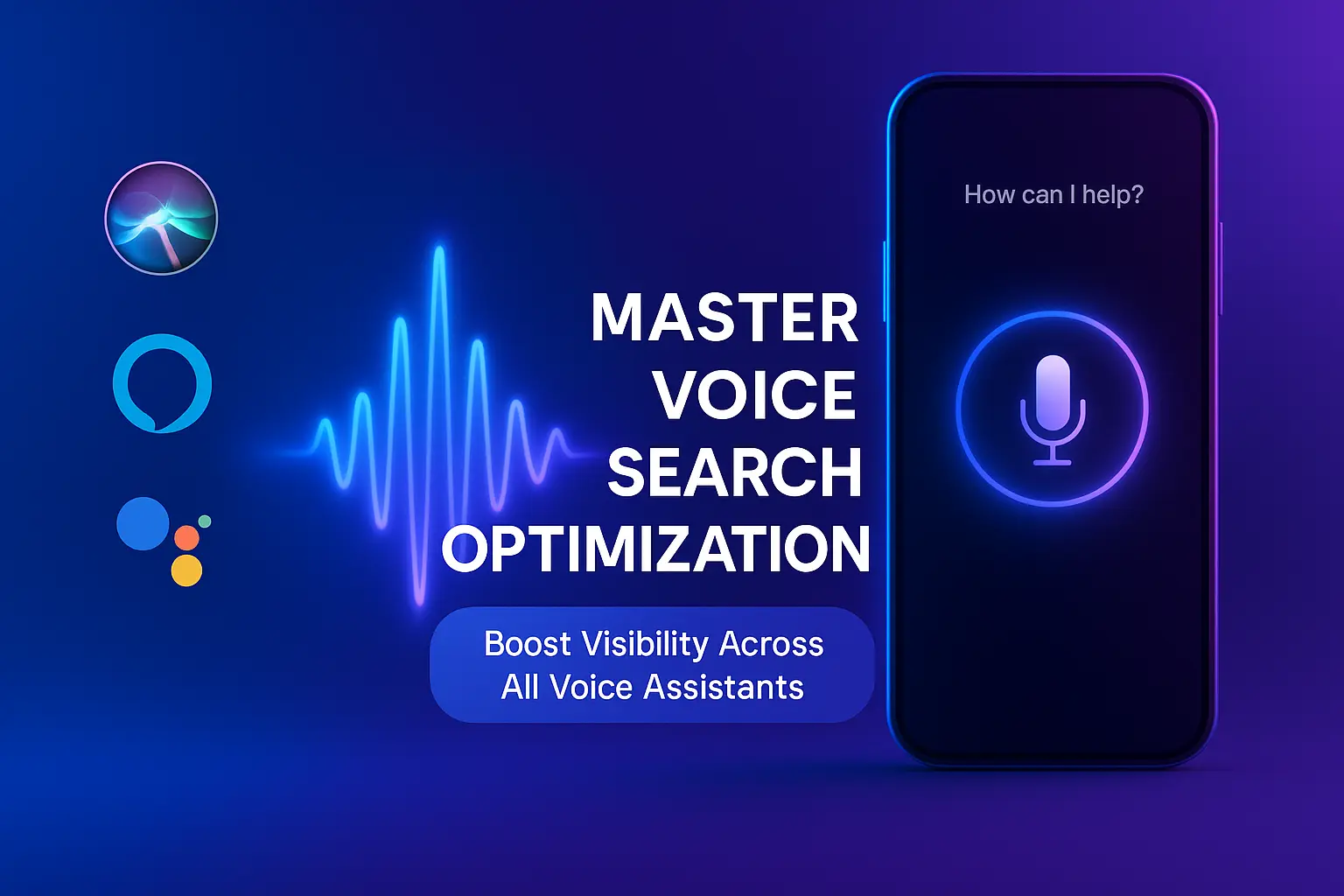Voice search is growing fast as more people use phones, smart speakers, and AI assistants to find answers. If your website is not ready for voice search, you may lose traffic to your competitors. This guide explains how voice search optimization works and gives you twelve simple tips to improve your results. It is written for SEO, AEO, GEO, and Semantic SEO so search engines and AI tools can understand it easily.
Table of Contents
ToggleWhat Is Voice Search Optimization
Voice search optimization is the process of making your website easy for voice assistants to read and understand. This includes Google Assistant, Siri, Alexa, and AI tools that read answers out loud. The goal is to appear as the single best answer for a spoken question. To do this, your content must be clear, direct, and written in natural language.

Why Voice Search Matters for SEO in 2026
More people use voice search every year because it is faster and easier than typing. Many voice searches are done on mobile devices and smart speakers. Users expect short answers that sound natural. Search engines pick results that answer questions clearly and provide trusted information. This makes voice search optimization important for rankings, visibility, and user experience.
How Voice Search Works
Voice search works by listening to your question, converting your voice into text, and searching for the best answer. The answer often comes from featured snippets, FAQs, and pages that use natural language. Search engines also look at local information, structured data, website speed, and mobile usability. If your content is clear, factual, and well structured, it is more likely to be chosen for voice search.
12 Tips to Improve Your Voice Search Optimization
1. Use Conversational Long Tail Keywords
Most voice questions sound natural. People say full sentences like how do I optimize for voice search instead of short phrases. Use these natural phrases in your content. Include questions that start with who, what, when, where, why, and how.
2. Focus on User Search Intent
Your keyword intent is informational. This means users want answers and explanations. Give clear answers at the beginning of each section. Match the words people actually say during voice searches.
3. Target Featured Snippets and Direct Answers
Voice assistants often read the featured snippet at the top of Google. To win this spot, answer questions in short paragraphs between forty and sixty words. Use clean formatting and clear headings to help search engines understand your content.
4. Optimize for Voice Search on Mobile
Most voice searches come from mobile devices. Your website must load fast, work on all screen sizes, and be easy to navigate. A mobile friendly site helps both voice search and normal search.
5. Improve Website Speed and Core Web Vitals
Fast websites rank higher in search and are more likely to be used for voice results. Reduce large images, use clean code, and remove anything that slows your pages. A fast loading site improves user experience and SEO.
6. Use Schema Markup and Structured Data
Schema markup helps search engines understand your content. Add FAQ schema, How To schema, Local Business schema, and other relevant types. This raises your chance of being used in voice search results. Structured data is a major part of AEO.
7. Create FAQ Based and Question Focused Content
Voice searches are question based. Add an FAQ section to every page. Write clear and direct answers. A clean question and answer format helps Google and voice assistants find the best information.

8. Strengthen Local SEO for Voice Searches
Many voice searches include near me or searches for local services. Keep your Google Business Profile updated. Add address, phone number, open hours, reviews, and service area. Use location based keywords. This helps your website appear for local voice queries.
9. Build Topic Clusters for Semantic SEO
Semantic SEO is the process of organizing your content by topics, not single keywords. Create one main guide and link it to smaller supporting articles. This helps search engines understand your expertise and improves rankings for related voice questions.
10. Improve Content Accessibility
Accessible content is easier for all users, including voice assistants. Use simple sentences, large text, clear headings, and readable structure. Add transcripts for audio and video. Good accessibility helps SEO, AEO, and GEO.
11. Increase Domain Authority and Trust Signals
Search engines want answers from trusted sources. Build authority by earning high quality backlinks, adding expert information, and keeping your site accurate and up to date. Strong authority makes your website more likely to rank for voice search.
12. Monitor and Test Your Voice Search Performance
Test your content on different devices like phones and smart speakers. Search your questions out loud and see what shows up. Track your keyword rankings and featured snippets. Update your content often to keep it fresh.
Voice Search Optimization for Industry Needs
Voice Search Optimization Services Overview
Voice search optimization services help businesses improve visibility in voice assistants and AI engines. They include keyword research, schema markup, Local SEO, content writing, and technical improvements to support voice based results.
Voice Search Optimization Techniques for Legal Services
Legal services need clear language because users often search for legal questions by voice. Use question based keywords, simple definitions, and location based information. Add detailed FAQs and structured data for legal topics.

Voice Search Engine Optimization for Local Businesses
Local businesses benefit from strong directory listings, updated profiles, and clear local content. Voice search often chooses nearby options first, so accurate local information improves your results.
Top AEO Services for Voice Search Optimization in North Dallas
Businesses in North Dallas can improve their AEO performance by adding structured data, building local listings, creating question based content, and optimizing for voice search keywords that mention the region.
Semantic SEO and Voice Search
Why Semantic SEO Helps Voice Search
Semantic SEO helps search engines understand meaning, not just keywords. It focuses on entities, topics, and relationships. This makes it easier for AI and voice assistants to select your content as the correct answer.
How to Use Semantic SEO Structuring
Use topic clusters, internal links, clear definitions, related questions, and supporting pages. Connect all pages around the main topic. This helps search engines understand your expertise and improves voice search rankings.

Frequently Asked Questions
How to optimize for voice search
You can optimize for voice search by using natural language, question based keywords, structured data, clear answers, and strong mobile performance. Aim for short and direct responses that voice assistants can read easily.
What is voice search optimization
Voice search optimization is the process of preparing your website for spoken search queries. It helps your content appear as the top answer when users ask questions on smart speakers, phones, and AI assistants.
How do you optimize for voice search
You optimize for voice search by improving speed, adding schema markup, using conversational keywords, building local SEO, and writing content with clear question and answer formatting.
How to optimize for voice searches
Write content that sounds natural when read aloud. Include long tail questions, short answers, and strong structure. Improve your mobile site, speed, and local profiles to support voice based results.
Final Thoughts
Voice search is a major part of modern search behaviour. By using conversational keywords, structured data, fast pages, and clear answers, you can improve your visibility across search engines and voice assistants. These twelve tips help you build a strong SEO, AEO, GEO, and Semantic SEO strategy that supports long term growth.








